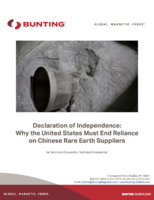QinetiQ's Zephyr Solar-Powered UAV Shatters Flight Endurance Record Using Advanced Composites Group's MTM®45-1 Prepregs
Share:

MTM®45-1 epoxy resin based carbon fibre prepregs manufactured by Advanced Composites Group (ACG), a member of Umeco Composites Structural Materials (UCSM) - a Division of Umeco plc, have been used in a number of formats by QinetiQ to manufacture the wing and fuselage frames for its record-breaking Zephyr solar-powered unmanned aerial vehicle (UAV).
Hand launched by a small team, QinetiQ's Zephyr UAV took to the skies above the US Army's Yuma Proving Ground in Arizona at 0640 local time (1440 BST) on Friday 9th July and remained aloft for 14 days and 21 minutes, having completed all aspects of its planned trial.
The previous 'official' record of 30 hours and 24 minutes, set by a US Global Hawk UAV, was smashed in an 'unofficial' attempt when an earlier version of Zephyr flew for 82 hours and 32 minutes in 2008. Following the recent record-breaking flight, Chris Kelleher, QinetiQ's chief designer said, "We have designed, built and delivered what will be remembered as a milestone in aviation history." He continues, "Zephyr will transform the delivery of current services such as communications, and lead to many new applications which are not possible or affordable by other means, and now await the FAI (World Air Sports Federation) official confirmation of the world records." QinetiQ's aim was to produce "the world's first truly eternal plane, capable of providing a low-cost, persistent surveillance capability over months rather than days", and it would seem that the company has achieved this.
The new record can be attributed in part to the extended wingspan, now 22.5 metre (74 foot), and performance enhancements afforded by aerodynamic features, such as the radical wing and tail designs. Weighing just over 50 kilograms, Zephyr flies on solar power generated by amorphous, wafer-thin silicon arrays attached to the aircraft's wings; these arrays recharge lithium-sulphur batteries during sunlight hours to provide the power overnight.
The recent flight demonstrates the use of solar-powered high-altitude, long-endurance (Hale) UAVs. In addition to the obvious defence and security applications, commercial uses include environmental research, monitoring crops and pollution, providing tactical intelligence over disaster zones or forest fires, plus delivering mobile communications capabilities in remote areas.
ACG's MTM45-1 is a variable cure temperature, high performance, toughened epoxy matrix system optimised for low pressure vacuum bag processing in both prepreg and film infusion formats. MTM45-1 can also be autoclave cured.
MTM45-1 may be cured at temperatures as low as 80°C, allowing the use of low cost tooling for prototypes and short production runs. After a free-standing 180°C post-cure, MTM45-1 is capable of 190°C/150°C dry/wet Tg and can offer a high level of damage tolerance
A number of MTM45-1 prepreg materials already have FAA approved design databases, allowing them to be used for Out-of-Autoclave (OoA) processed certified aircraft structures without extensive qualification testing. This offers considerable up-front cost savings, as well as lower manufacturing costs when compared to autoclave processes.
For further information, please contact:Advanced Composites Group
Roger Francombe - UK Aerospace Business Manager
Telephone: +44 (0)1773 766200
E-mail: rfrancombe @ acg.co.uk




